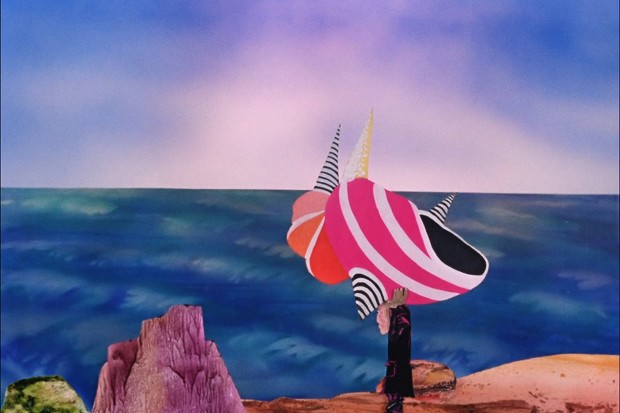GoCritic! Feature: Films from Studio Filmów Rysunkowych
- Fest Anča embraces diversity in animation, presenting intriguing films from all over the world, and one acclaimed institution appearing in this year’s programme is Poland’s Studio Filmów Rysunkowych, based in Bielsko-Biała

Studio Filmów Rysunkowych has a rich history of animated film production stretching across seven decades. Despite this dauntingly substantial wealth of material, Fest Anča selected the titles for the studio’s retrospective meticulously. The results took viewers on a journey through the years, with special attention paid to Polish animation's golden era of the 1960s and ‘70s. All the films in the block shared features characteristic of the Polish Animation School, challenging the viewer’s train of thought. This philosophical approach was well aligned with the festival’s theme of “Utopias”; in other words, building worlds anew.
The block began with the six-minute movie Paradise (1975) by Jan Petreszyn. Although Petreszyn is mostly associated with cartoons dedicated to younger audiences, in Paradise he aims his metaphors at mature viewers. The protagonist is a man overwhelmed by fast-developing civilisation from which he seeks refuge. The viewer is surrounded by a cacophony of voices, fast-changing images and distorted faces reminiscent of Picasso. Visually, the animation style echoes Terry Gilliam during his Monty Python's Flying Circus days. Overall, the film uses a delightful array of techniques to illustrate the human condition.
Continuing with this concept of variety, Fairy Tales (1981) by Maciej Albrecht reminds viewers of the abundance of tales in popular culture, while introducing twists; for example, no-one would expect rude behaviour from Sleeping Beauty, nor a king exposing his buttocks… This eight-minute production combines various drawing styles, warning the audience that nothing can be taken for granted.
The block also invited viewers on a rollercoaster-ride of emotions, the next offering startling viewers with its gloomy vision of the future: Tomorrow (1974; 10-minute runtime) by Marian Cholerek sees people deprived of emotions, acting in a contemptible manner and not thinking for themselves. This script penned by Józef Zięba is reinforced by imagery which comes across as deliberately scruffy so as best to mirror the decay of humanity.

Similarly disreputable acts feature in the block's most recent film, The Curse (2020; 8-minute runtime) by Piotr Kabat. The movie juxtaposes two worlds, exploring how their native creatures influence one another unknowingly. The film combines traditional hand-drawn animation with a 3D approach, which helps viewers get to grips with the plot. Kabat’s use of symbols relating to God is especially appealing. Ultimately, hints like these provide us with new paths for interpreting our existing knowledge and faith.
The issue of what people believe in was also addressed in The Message (2004) by Agnieszka Magnuszewska-Oczko. This four-minute production is a tear-jerking story following people who find themselves inundated with unpleasant news. Meanwhile, a little girl tries to grasp what lies beyond words and images. Rich in metaphor and symbolism, the film is still relevant nearly 20 years on, in terms of how mass media can manipulate people’s thinking.
An earlier analysis of a similar kind of manipulation, Mirosław Kijowicz’s The Banner (1965; 7-minute runtime) offers sensitive opposition to the jackboot of the communist regime in Poland: the story of a man who forgets his banner for a parade becomes a pretext for exploring the many negative aspects of Soviet domination, such as society’s blind opportunism. What’s more, thanks to the film score composed by jazzman Krzysztof Komeda (also responsible for the soundtrack for Roman Polański’s Rosemary’s Baby), the protagonist’s frantic search for the banner becomes music to viewers’ ears.
The second Petreszyn film in the programme was a satire outlining the downfall of men fixated with attractive women, entitled Have You Ever Been in Warm Countries? (1973; 6-minute runtime). The holiday vibe of this film serves as intriguing cover for studying the male gaze. Alfred Ledwig and his allegorical story about a society trying to launch a rocket is likewise characterised by a satirical approach: simple yet revealing, Eureka (1968; 8-minute runtime) explores the mechanisms people deploy when facing challenges.
This year saw Fest Anča exploring how we can construe new, personal worlds, and it is remarkable that Studio Filmów Rysunkowych - known predominantly for children’s films - have succeeded in creating memorable worlds for both children and adults over so many years. The afore-mentioned productions shed light on an issue which is indispensable for building the world anew: they urge adults to think outside the box, a skill which comes far more easily to children.
Did you enjoy reading this article? Please subscribe to our newsletter to receive more stories like this directly in your inbox.















